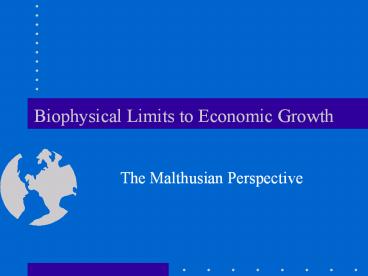Biophysical Limits to Economic Growth - PowerPoint PPT Presentation
Title:
Biophysical Limits to Economic Growth
Description:
Biophysical Limits to Economic Growth The Malthusian Perspective Introduction For the rest of this quarter, we will attempt to systematically explore the association ... – PowerPoint PPT presentation
Number of Views:54
Avg rating:3.0/5.0
Title: Biophysical Limits to Economic Growth
1
Biophysical Limits to Economic Growth
- The Malthusian Perspective
2
Introduction
- For the rest of this quarter, we will attempt to
systematically explore the association of
ecological limits and economic growth. - The main questions that would be addressed are
Can we expect unlimited economic growth in a
world endowed with finite resources? If
ecological limits are important factors in
determining future trends of ...
3
continue...
- economic growth, what steps or precautions
should be taken in order to avoid transgressing
these biophysical limits? - Three approaches
- The Malthusian Perspective
- The Neoclassical economic perspective
- The Ecological economic perspective
4
The Simple Malthusian Model
- Basic Postulates of the Malthusian doctrine of
resource scarcity and economic growth - Resources are scarce in absolute terms --
resources are available in finite amount. - If uncontrolled, the tendency of human population
is to grow exponentially. - Technology should not be perceived as the
ultimate escape from the problem of resource
scarcity.
5
continue...
- Thomas Malthus (1766- 1834)
- An Essay on the Principle of Population as Its
Affects the Future Improvement of Mankind (1798) - Basic Assumptions of the model
- The total amount of land available for
agriculture is immutably fixed - The growth of population is limited by the amount
of food available for subsistence. - Human population will invariably increase where
the means of subsistence increase.
6
continue...
- Malthus famous doctrine or assertion
- if not prevented by some checks, the tendency is
for the population to grow geometrically (2, 4,
8, 16, etc.) while the means of subsistence grows
arithmetically (1, 2, 3, 4, etc.) Unless this
tendency of ever-increasing imbalance between the
grrowth of population and the means...
7
continue...
- of subsistence is resolved by moral restraints
(negative checks), in the long run vice and
misery (positive checks) will ultimately
repress the superior power of population to a
level consistent with means of subsistence. - Explain this using Figure 6.1 from the text.
8
continue
- Criticisms of the Malthusian Simple Model
- It ignores the institutional factor that affect
population growth - Overlooks the important role that technology
plays in ameliorating resource scarcity - It could be considered ecologically naïve. Does
not go beyond the acknowledgement of the
finiteness of resources.
9
The Ehrlich-Commoner Model
- The model starts with the premise that all human
activities modify the natural environment to some
extent. In its simplest form, this model can be
mathematically expressed as follows - I P x F
10
continue...
- The variable I represents the total
environmental effect or damage measured in some
standard unit, P is a variable representing
population size in terms of head count, and F
is an index that measures the per capita impact
(damage) to the environment. - F fP, c, g(t)
11
Paul Ehrlich Model
- Population, P, plays a primary role in explaining
the impact human activities have on the
environment and resource use. - I P x F
- Two factors
- Increase population itself
- impact on per capita impact (increase in F) do
to the Law of Diminishing Marginal Product. That
is, F, is an increasing function of population.
12
continue...
- In conclusion, if other factors are held
constant, successive addition of people would
require increased use of resources, such as
energy, water, fertilizer, pesticides, and other
renewable and nonrenewable resources. Thus as
population continued to grow, the per capita
impact, in terms of pf resource depletion and
environmental deterioration, would increase
successively.
13
Per Capita Consumption, C
- If population, consumer preference and technology
are held constant, an increase in per capita
consumption, c, would only result form increased
use of resources (hence, environmental damage).
Explain using graph - Some scholars, for example, Durning, asserts that
over consumption is the main culprit of
environmental deterioration and resource
depletion.
14
Commoners Model
- Modern technology is the main source of
environmental problems. - Commoner views modern technology as being
ill-conceived and not wisely applied in the
production of goods and services. - Why? See next slide
15
continue...
- Because the decisions to change the composition
of economic input and output is made purely on
the basis of technical efficiency (increase per
capita production), rather than the impacts these
decisions ma y possibly have on the environment. - (See page 126 in the text)































